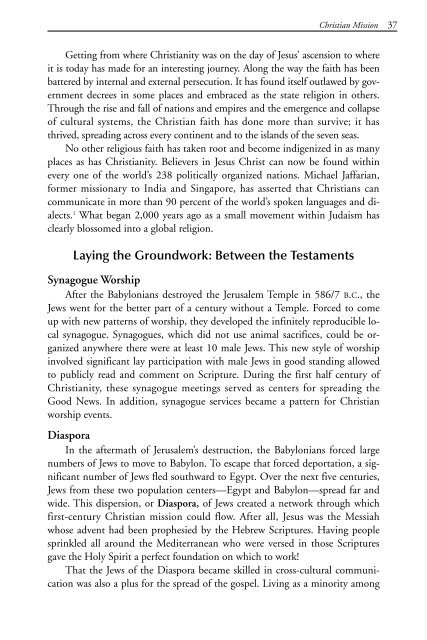discovering missions - Southern Nazarene University
discovering missions - Southern Nazarene University
discovering missions - Southern Nazarene University
Create successful ePaper yourself
Turn your PDF publications into a flip-book with our unique Google optimized e-Paper software.
245187 Disc Missions ins 9/6/07 1:04 PM Page 37<br />
Getting from where Christianity was on the day of Jesus’ ascension to where<br />
it is today has made for an interesting journey. Along the way the faith has been<br />
battered by internal and external persecution. It has found itself outlawed by government<br />
decrees in some places and embraced as the state religion in others.<br />
Through the rise and fall of nations and empires and the emergence and collapse<br />
of cultural systems, the Christian faith has done more than survive; it has<br />
thrived, spreading across every continent and to the islands of the seven seas.<br />
No other religious faith has taken root and become indigenized in as many<br />
places as has Christianity. Believers in Jesus Christ can now be found within<br />
every one of the world’s 238 politically organized nations. Michael Jaffarian,<br />
former missionary to India and Singapore, has asserted that Christians can<br />
communicate in more than 90 percent of the world’s spoken languages and dialects.<br />
1 What began 2,000 years ago as a small movement within Judaism has<br />
clearly blossomed into a global religion.<br />
Laying the Groundwork: Between the Testaments<br />
Christian Mission 37<br />
Synagogue Worship<br />
After the Babylonians destroyed the Jerusalem Temple in 586/7 B.C., the<br />
Jews went for the better part of a century without a Temple. Forced to come<br />
up with new patterns of worship, they developed the infinitely reproducible local<br />
synagogue. Synagogues, which did not use animal sacrifices, could be organized<br />
anywhere there were at least 10 male Jews. This new style of worship<br />
involved significant lay participation with male Jews in good standing allowed<br />
to publicly read and comment on Scripture. During the first half century of<br />
Christianity, these synagogue meetings served as centers for spreading the<br />
Good News. In addition, synagogue services became a pattern for Christian<br />
worship events.<br />
Diaspora<br />
In the aftermath of Jerusalem’s destruction, the Babylonians forced large<br />
numbers of Jews to move to Babylon. To escape that forced deportation, a significant<br />
number of Jews fled southward to Egypt. Over the next five centuries,<br />
Jews from these two population centers—Egypt and Babylon—spread far and<br />
wide. This dispersion, or Diaspora, of Jews created a network through which<br />
first-century Christian mission could flow. After all, Jesus was the Messiah<br />
whose advent had been prophesied by the Hebrew Scriptures. Having people<br />
sprinkled all around the Mediterranean who were versed in those Scriptures<br />
gave the Holy Spirit a perfect foundation on which to work!<br />
That the Jews of the Diaspora became skilled in cross-cultural communication<br />
was also a plus for the spread of the gospel. Living as a minority among

















